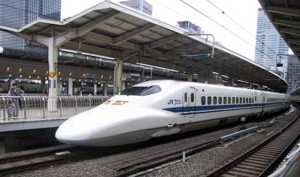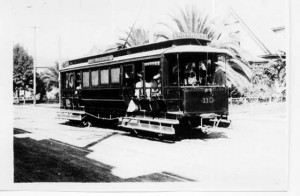
Could Detroit find new opportunity reusing idled plants to produce an American bullet train?
When you spend as much time on the road, as I do, especially overseas, you start realizing that automobiles really aren’t the only way to get around. Even in car-centric states like California, mass transit is gaining traction. In Europe and Japan, rail is increasingly the way to go, whether for your daily commute, or to travel cross-country.
And if President Obama has his way, the same thing could happen here. The president wants to spend $13 billion to seed the development of a nationwide, high-speed rail network, much like Japan’s legendary bullet trains and the nearly 200 mph French TGV. The White House this week identified 10 possible routes, including a network in California, and others along the East Coast.
The president also gave a boost to long-standing hopes to create a Midwest high-speed rail system that would have its hub in Chicago, and link to cities including St. Louis, Milwaukee and Detroit.
“This was incredible,” responded Rick Harnish, executive director of the advocacy group, the Midwest High Speed Rail Association, in an interview with the Detroit Free Press. “He has set a new direction for the country” – and not only for the millions of potential passengers advocates believe a U.S. bullet train could lure out of cars and airplanes.
 Could the development of high-speed rail create a new business model for Detroit’s struggling Big Three?
Could the development of high-speed rail create a new business model for Detroit’s struggling Big Three?
While we associate the names, General Motors, Ford and Chrysler with automobiles, the makers have had a history of producing other forms of motorized transportation over the last century.

Detroit automakers were also aviation pioneers, with products such as this Ford Trimotor.
Detroit was, in fact, a pioneer in the aircraft business. Henry Ford built the world’s first true airport, which used a site now serving as the automaker’s Dearborn test track. And the Ford Trimotor was one of the first truly successful commercial aircraft. During the first and second World Wars, Detroit manufacturers, past and present, produced a significant share of the aircraft America flew against its enemies, including the B-17s that rolled out of the Willow Run factory, west of Detroit.
When it comes to the rails, Detroit’s history is mixed. Motown manufacturers were among the many producers of rail cars and General Motors continued to produce diesel locomotives until relatively recently. Anyone who saw the comic film, “Who Framed Roger Rabbit,” will recall the sinister sub-plot to eliminate the Red Cars, the trolleys that once rolled across greater Los Angeles. To this day, historians continue to debate whether GM and its automotive brethren really did play a role in killing off regional rail systems, not only in L.A., but in Detroit and other parts of the country.
But there was a time, back in the 1970s, when the Big Three were positioning themselves to take advantage of a potential mass transit revival. In fact, Ford set up a prototype “people mover” system connecting the Hyatt Regency hotel, in Dearborn, Michigan, headquarters, with the Fairlane Town Center mall. The automaker originally hoped to connect the elevated system with its corporate headquarters and other nearby buildings, but eventually abandoned the project. The rail system was eventually scrapped.
When Detroit finally launched its first downtown rail system, the People Mover, two decades ago, it had to turn to a foreign supplier for the rolling stock.
But with the nation seemingly ready to embrace a new era of rail, whether high-speed inter-city, or local commuter lines, could the Big Three seize the opportunity? There are certainly plenty of empty factories, never mind the unemployed laborers skilled in bending metal.

Many blame Detroit for helping kill local mass transit systems, such as L.A.'s Red Car. Could Motown atone for past sins -- and turn a profit -- by supplying a new U.S. high-speed rail system?
And it wouldn’t be entirely unheard of. Worldwide, a number of automakers are involved in other lines of work. Though the network is complex, Hyundai has connections to a “chaebol” that produces all sorts of transportation systems, including ships. And then there’s Honda, which sees itself not as an auto company, but a producer of motorized vehicles. That takes in just about everything from generators to lawnmowers to the new Honda BusinessJet.
Detroit could follow a worse example.

As far as the debate about GM, Standard Oil etc. is concerned the evidence I have seen points to colusion of the big industries. Whats good for General Motors, you know the rest.